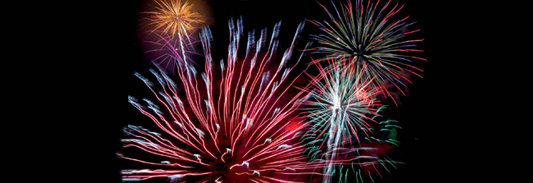Injuries from Fireworks

Though they can be exciting, festive and fun, it is important to remember that fireworks are also dangerous (CDC 2000). In 2005, an estimated 10,800 people were treated in U.S. emergency departments for fireworks-related injuries (Greene & Joholske 2006). The U.S. National Fire Protection Association and CDC strongly recommend that fireworks be used only by professionals.
- When do these injuries happen? Typically, 60% of injuries from fireworks in the United States occur in the month surrounding the July 4th holiday (Greene & Joholske 2006).
- What types of fireworks cause injuries? Between June 18 and July 18, 2005, firecrackers (26%), sparklers (17%), and rockets (17%) accounted for most of the injuries seen in emergency departments. Sparklers were associated with over half of the estimated injuries among children under 5 years, during the same time period (Greene & Joholske 2006).
- Who is likely to be injured? During the month around Independence Day (July 4th), children 14 years and younger sustained about 45% of injuries related to fireworks (Greene & Joholske 2006).
- What kinds of injuries occur? Injuries from fireworks most often affect the hands, eyes, and the head, face, and ear (Greene & Joholske 2006).
Under the Federal Hazardous Substances Act, the federal government banned the sale of the largest and most dangerous fireworks to consumers. Some states have banned the general public’s use of fireworks altogether. Between 2000-2005, more than one third of the fireworks-related deaths involved professional devices that were illegally sold to consumers (CPSC 2006). The safest way to prevent fireworks-related injuries is to leave fireworks displays to trained professionals.
For More Information
- CDC. Brief Report: Injuries Associated with Homemade Fireworks --- Selected States, 1993—2004. MMWR 2004: 53(25);562-563
- CDC's Fireworks-related Injuries Fact Sheet
- CDC. Notice to Readers: Injuries from fireworks in the United States. MMWR 2000:49(24);545-6
- Cooper D, Wilburn R, Ehrlich J, Welles WL, Stemmons S, Gunnells L, Horton DK, Kaye WE. Brief report: injuries associated with homemade fireworks ---selected states, 1993—2004. MMWR 2004:53(25);562-563
- U.S. Consumer Product Safety Commission, Fireworks Safety Web Site
- U.S. Fire Administration, The Dangers of Fireworks
- U.S. National Fire Protection Association Fact Sheet on Fireworks (
 653KB, 49 pages)
653KB, 49 pages)
References
CDC. Notice to Readers: Injuries from fireworks in the United States. MMWR 2000:49(24);545-6
Greene MA, Joholske J. 2005 Fireworks Annual Report: Fireworks-Related Deaths, Emergency Department Treated Injuries, and Enforcement Activities during 2005. Washington (DC): U.S. Consumer Product Safety Commission; 2006 [cited 27 Jan 2007]. Available at URL: www.cpsc.gov/LIBRARY/2005fwreport.pdf ( PDF 105KB, 29 pages) *
U.S. Consumer Product Safety Commission. CPSC warns consumers that using professional fireworks often has deadly results. [cited 27 Jan 2007]. Bethesda (MD): U.S. Consumer Product Safety Commission; 2006a. Available at URL: www.cpsc.gov/cpscpub/prerel/prhtml06/06197.html. *
Contact Us:
- Centers for Disease Control and Prevention
National Center for Injury Prevention and Control (NCIPC)
4770 Buford Hwy, NE
MS F-63
Atlanta, GA 30341-3717 - 800-CDC-INFO
(800-232-4636)
TTY: (888) 232-6348
24 Hours/Every Day - cdcinfo@cdc.gov

